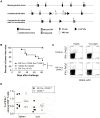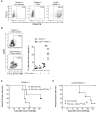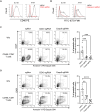CD8+ T cell-derived CD40L mediates noncanonical cytotoxicity in CD40-expressing cancer cells
- PMID: 40397730
- PMCID: PMC12094236
- DOI: 10.1126/sciadv.adr9331
CD8+ T cell-derived CD40L mediates noncanonical cytotoxicity in CD40-expressing cancer cells
Abstract
T cells and their effector functions, in particular the canonical cytotoxicity of CD8+ T cells involving perforin, granzymes, Fas ligand (FasL), and tumor necrosis factor related apoptosis inducing ligand (TRAIL), are crucial for tumor immunity. Here, we reveal a previously unidentified mechanism by which CD40L-expressing CD8+ T cells induce cytotoxicity in cancer cells. In murine models, up to 50% of tumor-specific CD8+ T cells expressed CD40L, and conditional CD40L ablation in CD8+ T cells alone led to tumor formation. Mechanistically, CD40L+CD8+ T cells can induce cell death in CD40-expressing cancer cells by triggering caspase-8 activation. We demonstrate that a gene signature for resistance to CD40 signaling-induced cell death strongly correlates with worse survival in different human cancer cohorts. Our results introduce CD40L as a rather counterintuitive, noncanonical cytotoxic factor that complements the capabilities of CD8+ T cells to combat cancers and has the potential to enhance the efficacy of immunotherapies.
Figures







Similar articles
-
CD40L expression by CD4+ but not CD8+ T cells regulates antiviral immune responses in acute LCMV infection in mice.Eur J Immunol. 2016 Nov;46(11):2566-2573. doi: 10.1002/eji.201646420. Epub 2016 Sep 20. Eur J Immunol. 2016. PMID: 27562840
-
Molecular requirements for CD8-mediated rejection of a MUC1-expressing pancreatic carcinoma: implications for tumor vaccines.Cancer Immunol Immunother. 2002 Aug;51(6):327-40. doi: 10.1007/s00262-002-0277-3. Epub 2002 May 4. Cancer Immunol Immunother. 2002. PMID: 12111121 Free PMC article.
-
Induction of cytotoxic effector cells towards cholangiocellular, pancreatic, and colorectal tumor cells by activation of the immune checkpoint CD40/CD40L on dendritic cells.Cancer Immunol Immunother. 2021 May;70(5):1451-1464. doi: 10.1007/s00262-020-02746-x. Epub 2020 Nov 12. Cancer Immunol Immunother. 2021. PMID: 33180184 Free PMC article.
-
Functions of CD40 and Its Ligand, gp39 (CD40L).Crit Rev Immunol. 2017;37(2-6):371-420. doi: 10.1615/CritRevImmunol.v37.i2-6.100. Crit Rev Immunol. 2017. PMID: 29773027 Review.
-
The role of CD40 ligand in costimulation and T-cell activation.Immunol Rev. 1996 Oct;153:85-106. doi: 10.1111/j.1600-065x.1996.tb00921.x. Immunol Rev. 1996. PMID: 9010720 Review.
References
-
- Russell J. H., Ley T. J., Lymphocyte-mediated cytotoxicity. Annu. Rev. Immunol. 20, 323–370 (2002). - PubMed
-
- Ridge J. P., Di Rosa F., Matzinger P., A conditioned dendritic cell can be a temporal bridge between a CD4+ T-helper and a T-killer cell. Nature 393, 474–478 (1998). - PubMed
-
- Bennett S. R., Carbone F. R., Karamalis F., Flavell R. A., Miller J. F., Heath W. R., Help for cytotoxic-T-cell responses is mediated by CD40 signalling. Nature 393, 478–480 (1998). - PubMed
MeSH terms
Substances
LinkOut - more resources
Full Text Sources
Medical
Molecular Biology Databases
Research Materials
Miscellaneous

